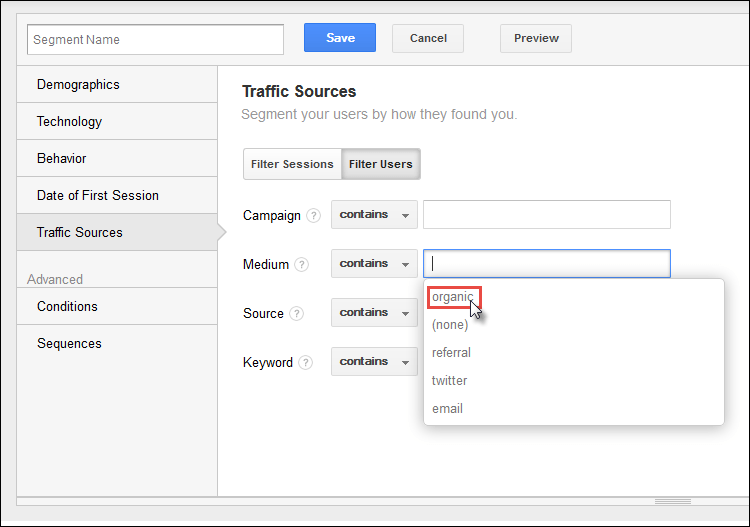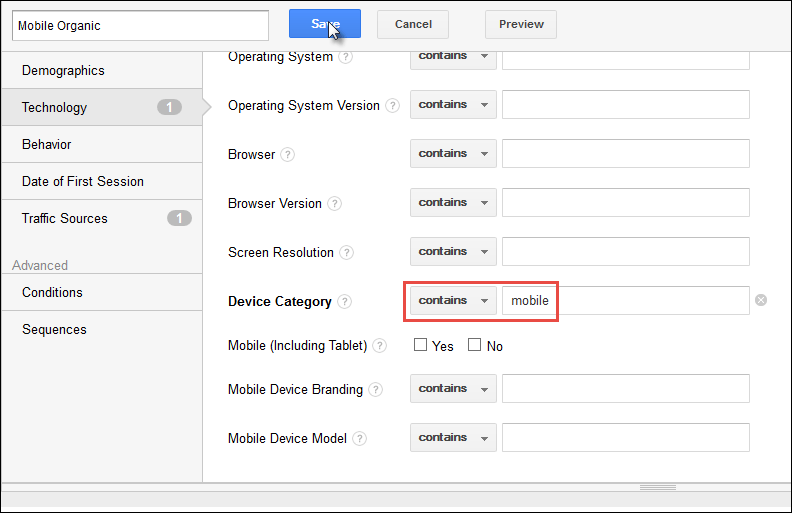
OK, so let’s breathe, everybody.
If you’re in the search marketing (or even in the digital marketing) space you’ve likely heard about Google’s unusual preemptive announcement of a pending algorithm update around mobile-friendly sites in search results. It has a lot of folks anxious, has been all over the news and is being billed as a major, impactful update.
That doesn’t necessarily mean the sky is falling on your website or business by end of day today.
First off, as Google’s Gary Illyes pointed out on Twitter, the update is rolling out over the course of the next few weeks:
@rustybrick to the best of my knowledge yes. Keep in mind that the rollout may take weeks so you might not see an immediate effect. #april21
— Gary Illyes (@methode) April 20, 2015
So if your site was showing as not being “mobile friendly” and you’re not seeing any movement yet, you might not yet be out of the woods.
If you do want to take an initial look at how your mobile traffic from organic search is doing, you can quickly look at your traffic metrics to help understand if there’s been a major change.
Within Google Analytics, you want to first create a new, custom segment:

Within that segment, you first want to add a filter for Traffic Sources > Medium > Organic:

Next, you can also add Technology > Device Category > Mobile:

You now have a segment for Mobile Organic traffic.
You can look next at a date range comparison of today’s traffic versus the same traffic last week (so that you’re comparing apples to as apple-like of a few hours of data as you can):

And then look specifically at hourly traffic to get an early look at how you’re faring compared to the same day the previous week:

This image above is from a smaller, older site my company owns that is not mobile-friendly per Google’s test.
As you can see there’s no early signs of impact, but that doesn’t mean that the site’s organic mobile traffic won’t be impacted over time. As with any small slicing it’s important to keep in mind that – in addition to the fact that the full impact of this mobile update hasn’t yet been felt – there could be a number of other factors at play if you’re seeing a major difference in traffic.
Questions to ask yourself include:
- Does most of your organic mobile traffic come from searches for your brand (even with a mobile-unfriendly site it’s not likely your brand will get nuked)?
- Or is your organic mobile traffic from a portion of your site that is mobile-friendly? I.e., your site’s inner pages could be poor user experiences on mobile but you may have a custom mobile design for the homepage, which may get most of your organic traffic from mobile searches.
- Did you run other promotions that may have impacted last week’s data (or today’s)?
- Could your site could have suffered from other ranking fluctuations not related to this latest algorithm update?
If you see an uptick in traffic, it may just be because some of your competitors have dropped out of search results (and you may see a negative impact of the update later as it continues to roll out).
You can look at a comparison versus a few previous Tuesdays in this way as well to get a sense of whether your numbers are significantly off. Assuming you’re not seeing anything alarming, you can continue to monitor your overall traffic using larger samples over time.
In my post earlier this month I also walked through some specific means of measuring your mobile traffic overall and for different sections of your site. Some tools are also starting to show mobile-friendly data already. SERPs offers mobile keyword rankings that highlight whether a listing is showing as “mobile-friendly” or not.
Glenn Gabe also points out that SEM Rush is offering a mobile-friendliness check as well:
Looks like @semrush added mobile data + mobile-friendly checks. Awesome additions to an already outstanding tool 
 pic.twitter.com/ANehl6GaZE — Glenn Gabe (@glenngabe) April 21, 2015
pic.twitter.com/ANehl6GaZE — Glenn Gabe (@glenngabe) April 21, 2015
If you are seeing a major drop in mobile traffic in the coming weeks and are looking for the quickest possible path to being more mobile-friendly and getting back some of your organic mobile traffic, below is some specific technical advice from my colleague Jamie Mazur, the co-founder and CTO at digital marketing agency All Points Digital:
Look at the analytics and review the traffic coming from mobile devices. Where possible, analyze what revenue or soft return is attached to those visitors. Armed with this information, make an informed decision on whether a potentially expensive “rush job” or throw-away short-term fix is worth the cost.
Your choices are:
- Ignore the deadline, and focus on creating a quality mobile-friendly user experience on your own timeline.
- Enlist whoever you need, regardless of time or cost, to beat the clock while implementing a lasting solution
- Hack in quick fixes to pass the “mobile-friendly” test to avoid the wrath of The Google
For those looking for the quick fix, there are a few basic strategies that we recommend:
- Attempt a Plug & Play Solution: If your site is built using a basic WordPress theme, check for an update that may make it responsive. If one is not available, take a look at plugins like Wptouch.
- Force Your Page to Fit: Uses the <meta name=”viewport” width=device-width initial-scale=1> tag appropriately. If you don’t know what this is, Google it or ask your developer.
- Add Rudimentary Responsive Design to Trouble Spots: Audit your page styling (CSS and HTML) for fixed-positioning, larger fixed-size images, and font sizes. Use media queries to remove or restyle elements that are too large or small for a mobile device.
- Let Google Be Your Guide: Use the mobile-friendly test. Treat the results as your to do list.
For those for whom it matters, there is still time to escape Mobilegeddon. Don’t try to boil the ocean – just grab the low-hanging fruit. It may not be perfect, but you will end up with a better mobile experience than you have today, and you will likely retain your search positioning.
If mobile traffic just does not mean that much to you today, take a few deep breaths. Stop circling April 21st on your calendar, but plan to act soon. You won’t want to be left on the outside looking in at the hordes of web traffickers happily engaging through their devices.
Google has already shared some helpful FAQ answers, and there are a number of interesting early reactions to the update from around the Twittersphere:
If you think Google is not going to rank a big brand in its niche cause their site is not “mobile-friendly”, i’ve got a bridge to sell you
— Branko Rihtman (@neyne) April 20, 2015
http://t.co/nB8WDsKP7C it is binary and real time. it is live tomorrow. but you might not notice it for a few weeks. #umm
— aaron wall (@aaronwall) April 21, 2015
No clear signs of algorithm flux last night, either on desktop or mobile.
— Dr. Pete Meyers (@dr_pete) April 21, 2015
Remember, when Google says “weeks”, that could mean 5% roll-out each day X 20 days, or 80% on day 1, and then +1%/day after.
— Dr. Pete Meyers (@dr_pete) April 21, 2015
Across 30,000 keywords, we are seeing a 1% shift in mobile friendly results #mobilegeddon
— rjonesx (@rjonesx) April 21, 2015
The #mobilegeddon change has increased to 1.5% shift towards mobile-friendly
— rjonesx (@rjonesx) April 21, 2015
Your turn: What are you seeing? How is your business responding?
![[Get] Is Google’s Mobile Deadline of April 21st The New Y2K?](https://seo.maxiaodong.com/wp-content/uploads/2017/06/Monthly-Report-760x558-150x150.png)
![[Get] Worldwide Reaction to #Mobilegeddon](https://seo.maxiaodong.com/wp-content/plugins/wordpress-23-related-posts-plugin/static/thumbs/15.jpg)
![[Get] Worldwide Reaction to #Mobilegeddon](https://seo.maxiaodong.com/wp-content/plugins/wordpress-23-related-posts-plugin/static/thumbs/4.jpg)
![[Get] 3 Ways to Erase Private Information from the Internet](https://seo.maxiaodong.com/wp-content/plugins/wordpress-23-related-posts-plugin/static/thumbs/0.jpg)
![[Get] Will Amazon Become the Source for Home Repair?](https://seo.maxiaodong.com/wp-content/plugins/wordpress-23-related-posts-plugin/static/thumbs/14.jpg)
![[Get] 16 Invoicing and Accounting Tools for Startups](https://seo.maxiaodong.com/wp-content/plugins/wordpress-23-related-posts-plugin/static/thumbs/20.jpg)
![[Get] Study: Searchers Use Question Formats 27% Of The Time](https://seo.maxiaodong.com/wp-content/uploads/2017/07/bluenile-searches-by-word-800x321-150x150.png)
![[Get] Instant Article Wizard 4.0 now](https://seo.maxiaodong.com/wp-content/plugins/wordpress-23-related-posts-plugin/static/thumbs/24.jpg)



![[GET] Viral Facebook Campaigns with Social Media & SEO Bonuses](https://seo.maxiaodong.com/wp-content/plugins/wordpress-23-related-posts-plugin/static/thumbs/5.jpg)